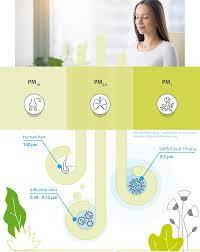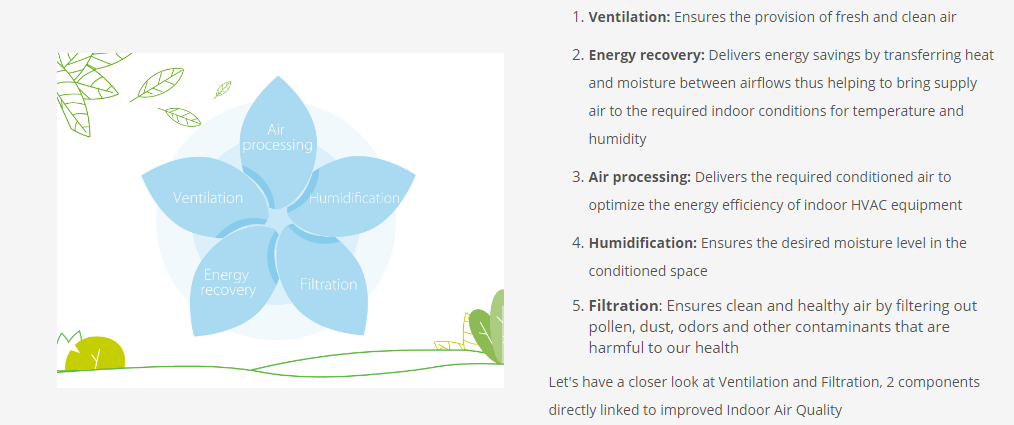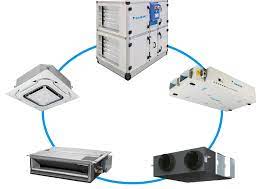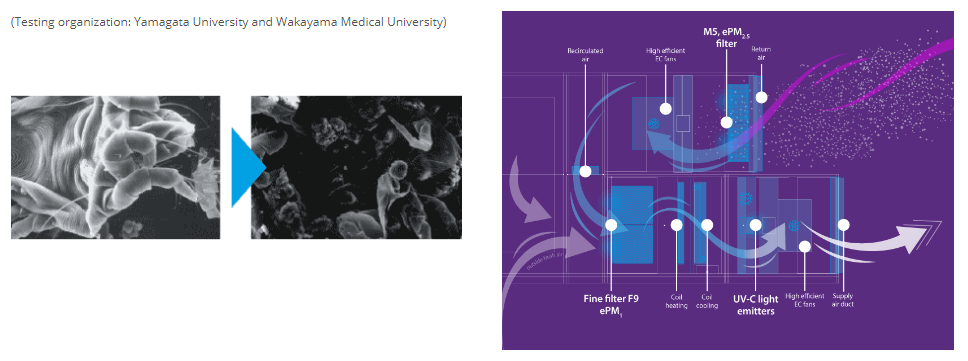Why Indoor Air Quality (IAQ) is Important
Indoor Air Quality (IAQ) is the air quality in a building or structure, the air that the occupants of the building breathe every day.
When planning new resiednetial buildings, schools, offices or light commercial buildings, many factors need to be considered. Apart from the construction factors, there are also issues of heating, cooling and something that is often neglected: indoor air quality.
Did you know that the indoor air we breathe, at home, in the office or even in a hotel room, can actually be much more poluted than the air outside?
- The 90% of our lives is spent indoors
- The indoor air quality can be 2-5 times worse than outdoor air quality because of pollutants, such as pollen, bacteria etc.
Pollutants And Indoor Air Particles
With the right system (air conditioner, ventilation, air purification equipment), contaminants such as pollen, spores, concrete dust, bacteria, viruses or germs can be removed from the air by filtration. The smaller these particles are, the more dangerous they are to our health, so particulate matter is categorized according to its size.
Particles And Storage Areas
The thinner and smaller a particle is, the longer it stays in the air.
• PM 10: all particles up to 10 µm (0.01 mm)
Deposition in the nose and pharynx of the human respiratory system
• PM 2.5: all particles up to 2.5 (m (0.0025 mm)
They are so small that they reach the human lung
• PM 1: all particles up to 1 µm (0.001 mm = 1 micron)
They are so small that they pass through the cell membrane of alveoli into the human circulatory system and cause life-threatening diseases.
Due to their harmful properties (high risk of cardiovascular disease), their permanence and frequency, particles smaller than 2.5 μm (ie PM 2.5 and PM 1 ) require the most attention .

Elements of indoor quality

Aeration
Ventilation systems ensure optimal air conditioning conditions by providing a fresh, healthy and comfortable environment for buildings of all dimentions and different applications. In a completely enclosed space in a bulding, air cannot enter/leave easly, leaving air pollutants remaining and accumulating in the room. This can effect the health of the people in the room. Ventilation is essential for diluting and removing these air pollutants. A well-maintained ventilation system and and adequate air exchange rate have proven to be an effective solution to protect people from contaminants, incluidng visruses.
Daikin ventilation products are perfectly combined in a total heat pump solution, so that it is possible to reduce the number of individual systems and independent suppliers for your HVAC-R system
To achieve optimal ventilation, Daikin maintains the highest standards of energy efficiency and has a wide range of options to achieve the filtration and level of hygiene required for your project.

Filtering

Filter efficiency classification
ISO 16890
With the introduction of the new ISO 16890 standard, the classification of filters is based on the ability to filter specific particles according to particle size.
A filter is classified in the ISO ePM 1 Filter Group if the minimum filter efficiency is at least 50% (the filter removes at least 50% or more particles ≤1 μm in size) as shown in the table.
The average filter performance is also indicated . If the average yield for ISO PM 1 particles is 68%, then the classification becomes PM 1 65% as the average yield is rounded down to the nearest 5% increase.
HEPA filters
HEPA filters provide extremely high particle filtration and must filter at least 99.95% of particulate matter with a diameter of 0.3 μm!
As such a HEPA filter is more efficient than an ePM 1 filter .
Air disinfection additives for filtration
With a good filtration system you can collect very small particulate matter from the air stream but the viruses, bacteria and fungal organisms that accumulate are not inactivated. They can continue to reproduce and possibly cause disease. To prevent this from happening, air disinfection is required.
Flash Streamer
Superior air treatment through the unique Flash Streamer technology
Daikin’s patented Flash streamer technology disables more than 99.9% of the new coronavirus (SARS-CoV-2).
The huge streamer discharge hits allergens and hazardous chemicals, breaking down and breaking down surface proteins, which are then destroyed by oxidation.
During the test, allergens are placed on the electrode of the streamer discharge unit and then photographed with the electron microscope after being irradiated.
UV-C lamp
UV energy inactivates viral, bacterial and fungal organisms so that they can not reproduce and possibly cause disease.
The entire UV spectrum has the ability to inactivate microorganisms, but UV-C energy (wavelengths 200 – 280 nm) provides the greatest microbicidal effect.
UV-C disinfection and sterilization is widely used in hospitals.
However, the UV-C lamp is a danger to the health of the human body.
By treating the fresh recirculation air with a UV-C lamp directly inside the air management units, pure germ-free air can be achieved without exposing the human body to the harmful UV lamp.

Contact Us If You Have Any Questions
Photo Credits: Shutterstock



